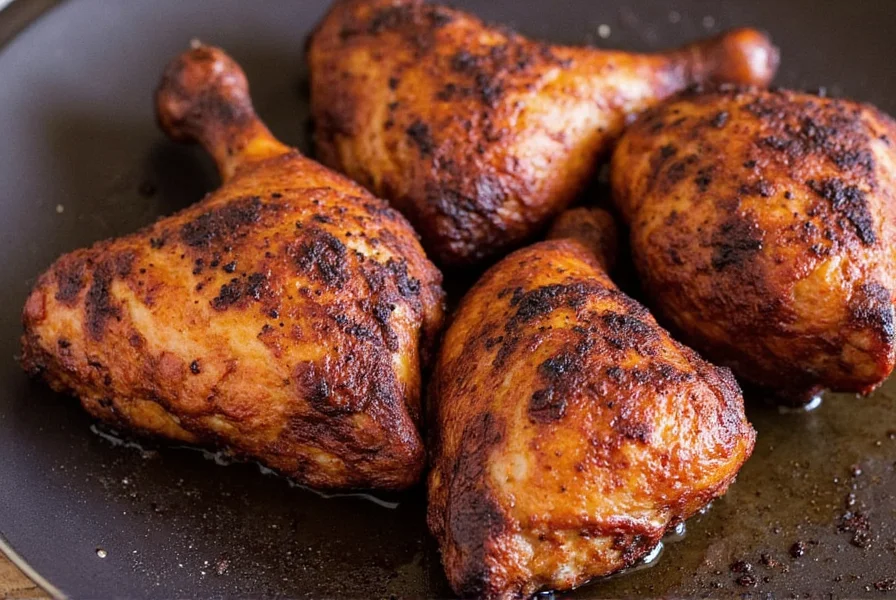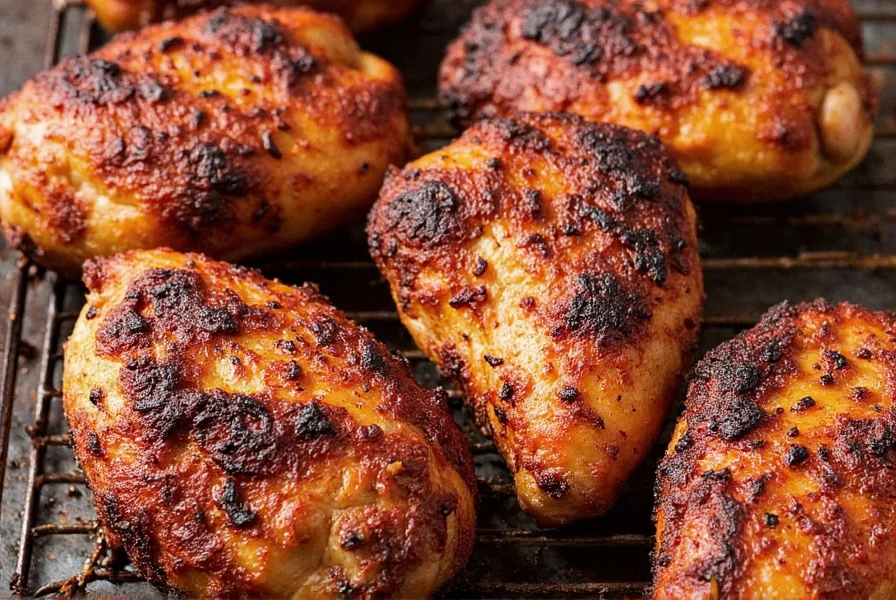Originating in Louisiana Creole cuisine, blackened chicken became popular nationwide after Chef Paul Prudhomme introduced it at his New Orleans restaurant in the 1980s. This cooking method creates a distinctive flavor profile that combines smoky, spicy, and aromatic elements without requiring lengthy marination.
The Blackening Process Explained
Unlike grilled or fried chicken, blackened chicken uses an extremely hot dry-heat cooking method. The process involves:
- Drying the chicken thoroughly (moisture prevents proper blackening)
- Coating generously with a spice mixture containing paprika, cayenne, garlic powder, onion powder, thyme, oregano, and black pepper
- Using a well-seasoned cast-iron skillet heated to smoking point
- Cooking briefly (2-3 minutes per side) until spices form a dark crust
The high heat causes the spices to toast and caramelize rapidly, creating the signature dark exterior while keeping the interior moist. Properly executed blackened chicken should have a dark brown to near-black crust that's flavorful but not burnt.

Blackened Chicken vs Similar Cooking Methods
Many people confuse blackened chicken with other preparation styles. Understanding these differences is essential for authentic preparation:
| Cooking Method | Temperature | Oil Used | Spice Application | Resulting Texture |
|---|---|---|---|---|
| Blackened | Very high (smoking point) | Minimal (just to coat skillet) | Generous dry rub before cooking | Dark crust, moist interior |
| Cajun Fried | Moderate-high | Submerged in oil | Often in batter or after frying | Crispy fried exterior |
| Grilled | Medium-high | Light coating on chicken | Before or during grilling | Char marks, smoky flavor |
| Seared | High | Moderate amount | After searing usually | Browned crust, no spice crust |
Essential Blackened Seasoning Components
The spice blend is crucial to authentic blackened chicken. While recipes vary, a traditional blackened seasoning contains these key elements:
- Paprika - Provides color and base flavor
- Cayenne pepper - Delivers heat (adjust to taste)
- Garlic powder - Adds savory depth
- Onion powder - Contributes sweetness
- Dried thyme and oregano - Herbal notes
- Black pepper - Sharp bite
- Salt - Enhances all flavors
- Optional: White pepper, cumin, or dried mustard
A common ratio for homemade blackened seasoning is 2 parts paprika to 1 part each of cayenne, garlic powder, and onion powder, with smaller amounts of the other spices. The spice mixture should coat the chicken generously - don't be shy with application.
Common Misconceptions About Blackened Chicken
Several myths surround this cooking technique:
- It's supposed to be burnt: The dark color comes from toasted spices, not actual burning. Proper blackened chicken shouldn't taste bitter.
- It's extremely spicy: While cayenne is traditional, heat levels can be adjusted to preference.
- It requires special equipment: While cast iron works best, other heavy-bottomed skillets can work with proper temperature control.
- It's the same as Cajun chicken: Blackening is a specific cooking technique, while Cajun refers to a broader flavor profile that can be achieved through various methods.

Perfecting Your Blackened Chicken Technique
For restaurant-quality results at home, follow these professional tips:
- Dry the chicken thoroughly: Pat with paper towels to remove all surface moisture
- Preheat your skillet properly: It should be smoking hot before adding chicken
- Don't overcrowd the pan: Cook in batches if necessary to maintain high heat
- Resist moving the chicken: Let it develop a proper crust before flipping
- Use ventilation: Blackening creates significant smoke - turn on your hood fan
- Rest before serving: Let chicken rest 5 minutes after cooking for juicier results
When executed properly, blackened chicken delivers an incredible flavor experience with minimal ingredients. The technique works best with boneless, skinless chicken breasts or thighs, though some chefs prefer bone-in cuts for additional flavor.
Serving Suggestions for Blackened Chicken
Traditional Louisiana accompaniments complement blackened chicken's bold flavors:
- Creamy grits or rice to balance the spice
- Simple green salad with lemon vinaigrette
- Roasted vegetables like asparagus or bell peppers
- Cold beer or crisp white wine
- Lemon wedges for brightening the rich flavors
For a complete meal, consider serving blackened chicken with a cooling remoulade sauce or a simple aioli to counterbalance the heat from the spices.
Frequently Asked Questions
What makes chicken blackened instead of just grilled?
Blackened chicken differs from grilled chicken primarily in the cooking method and spice application. Blackening uses a very hot dry skillet with a generous spice rub that forms a dark crust through the Maillard reaction, while grilling typically involves indirect heat with spices that don't create the same dark, flavorful crust. The blackened technique creates a more intense spice flavor throughout the exterior.
Is blackened chicken supposed to be burnt?
No, properly prepared blackened chicken should not be burnt. The dark color comes from the Maillard reaction and slight charring of the spice mixture, not from burning the chicken itself. The crust should be dark brown to nearly black but still flavorful, not bitter. If your blackened chicken tastes burnt, the skillet was likely too hot or the chicken cooked too long.
What's the difference between blackened and Cajun chicken?
Blackened refers specifically to the cooking technique (high-heat searing with spice rub), while Cajun describes a flavor profile originating from Louisiana. All blackened chicken uses Cajun-inspired spices, but not all Cajun chicken is blackened - it could be grilled, fried, or baked. The blackening process creates a distinctive crust that other Cajun preparation methods don't achieve.
Can I make blackened chicken without creating so much smoke?
While some smoke is inevitable with authentic blackened chicken (due to the extremely high heat required), you can minimize it by ensuring your stove hood fan is on high, opening windows, and using a well-seasoned cast iron skillet. Some home cooks reduce the heat slightly (though this affects authenticity) or finish cooking in a 400°F oven after initial searing to reduce smoke while maintaining flavor.
What are the essential spices in blackened chicken seasoning?
The essential spices for authentic blackened chicken seasoning include paprika (for color and base flavor), cayenne pepper (for heat), garlic powder, onion powder, dried thyme, dried oregano, and black pepper. Salt is also crucial for enhancing all the flavors. The paprika-to-cayenne ratio determines the heat level, with traditional recipes using about 2 parts paprika to 1 part cayenne.










 浙公网安备
33010002000092号
浙公网安备
33010002000092号 浙B2-20120091-4
浙B2-20120091-4